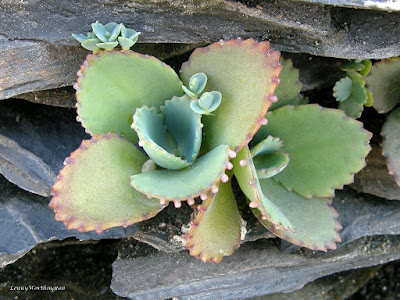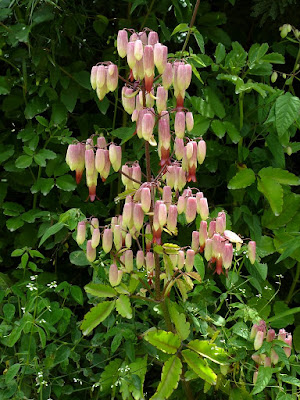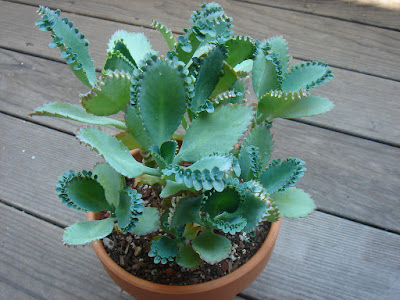Bryophyllum pinnatum also called as Kalanchoe pinnata, The air plant, Cathedral bells, Life plant, Miracle leaf, Goethe plant, is a species of the Bryophyllum genus. The specific epithet "pinnata" is the feminine form of the Latin adjective pinnatus, meaning "winged, pinnate".
Bryophyllum pinnatum also called as Kalanchoe pinnata, The air plant, Cathedral bells, Life plant, Miracle leaf, Goethe plant, is a species of the Bryophyllum genus. The specific epithet "pinnata" is the feminine form of the Latin adjective pinnatus, meaning "winged, pinnate".
IDENTIFY BRYOPHYLLUM PINNATUM - KALANCHOE PINNATA
Bryophyllum pinnatum is native to Madagascar but widely distributed on plains, tropical and temperate regions of Africa, Australia and America. It is a common weed in banks, hummocks, waste grounds and thickets in dry and wet regions, ascending to 1400 meters, on foothills and along the slopes especially in the thin layer of soil by exposed rocks.
It is a water-storing perennial that grows about 1 to 1.5 m tall. In young plants the oppositely arranged leaves are simple becoming tri-pinnately compound as the plant matures. The leaf/leaflets are elliptic to 20 cm in length with a notched margin that produces plantlets and a rounded apex.
Kalanchoe pinnata blooms in winter-spring with the pendulant, actinomorphic flowers that are arranged in large panicles. The calyx has 4 fused sepals forming a tube. The corolla has 4 fused petals forming a tube that exceeds the calyx. There are 8 stamens fused to the base of the corolla. The ovary is superior with 4 locules and numerous seeds. The fruit is a capsule at maturity.
In other areas of the Caribbean it is used as a cooling tea or as a poultice for sores. It is also grown as an ornamental but can become problematic as it spreads rapidly by vegetative reproduction. It is traditionally known to exhibit a wide range of pharmacological activities that involves treatment for the most serious disorders related to mankind.
BRYOPHYLLUM PINNATUM - KALANCHOE PINNATA CARE AND CULTURE
Cultural information should only be used as a guide, and should be to be adapted to suit you. Your physical location; where you grow your plants, how much time you have to devote to their care, and many other factors, will need to be taken into account. Only then can you decide on the cultural methods that best suit you and your plants.
Light:
Bryophyllum pinnatum loves and needs plenty of light to grow, if light is adequate its leaves will develop a beautiful reddish outline. During summer do not allow direct sunlight because its leaves who contain lots of water will get sun-burned. Direct sunlight from fall till early spring will not harm your plant.
Temperature:
Kalanchoe pinnata need warm temperatures. In the moderate climate it can be as easily grown indoors and outdoors but only in pots and not in the ground. Temperatures between 60 °F and 85 °F are ideal for development and blooming of the plant. It is very sensitive to cold and it takes only a few hours of near 40 °F for the plant to die. Avoid placing it near drafts or cool windowsills.
Substrate and growing media:
Bryophyllum pinnatum love to be alone in small pots. However, the larger the pot the larger the leaves but the size of the top will hardly affect blooming or rate of growth. Avoid planting companion plants in the same pot and repot each spring adding fresh soil.
Their root system is extremely sensitive and it would be advisable to use clay pots that allow better aeration of the roots. Ensure excellent drainage by placing pebbles at the bottom of the pot and use light soil containing lots of peat moss, perlite and sand.
Watering:
Provide plenty of water when the soil seems dry to the touch but do not overwater because the roots will rot. If you have the time, let the water sit for a while before watering so that it will get the temperature of the environment.
These plants can stand dry conditions but do not let them dry out completely because it will greatly compromise its growth. The plant will need some time to get back into shape and avoid wetting the leaves when watering. Always empty excess water from the tray and never let your pot stand in water.
Fertilizer:
Bryophyllum pinnatum need only very little fertilizer. Generally the plants should have a good supply when you buy them in the store, so you should not need to worry for the first few months. If you want to keep your plant past the first flower, start fertilizing only when you see new growth on the plant. Use standard pot plant fertilizer (like 20-8-20) once every second week at 1/4 to 1/2 of the recommended rate.
Rest period:
When the flowers start to die back, cut them off and let the plant rest. After deadheading, you should reduce watering as the plant will need less water during this resting period. Soon you will notice new buds and your plant will bloom again. This change in blooming and resting cycles will go on throughout the year irrelevant to seasons.
Pests and diseases:
Kalanchoe pinnata are resistant to disease and insects but if kept outdoors, could eventually be affected by aphids, scale, spider mites and nematodes. Common symptoms include apart from insects themselves on the crossing of the stems or the undersides of leaves, the presence of honeydew on leaves, creased faded leaves and webs, or leaves that look torn or bitten.
Propagation:
Bryophyllum pinnatum is easily propagated by seed or leaf, stem, or tip cuttings. New plantlets will occasionally appear at leaf margins and may be removed and potted up individually


















COMMENTS